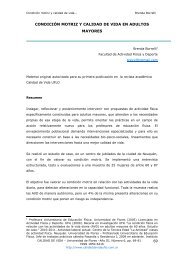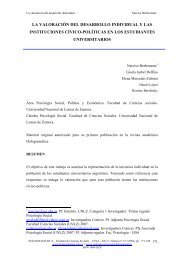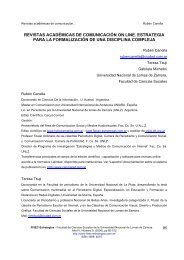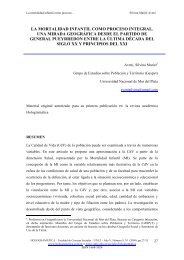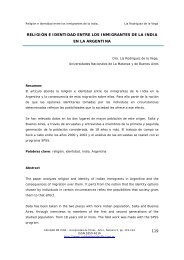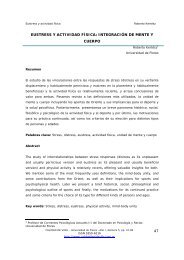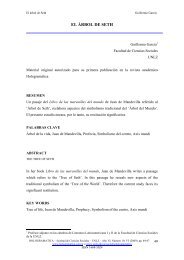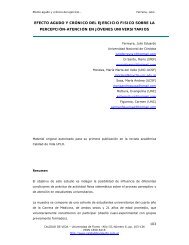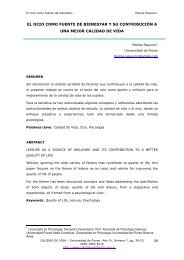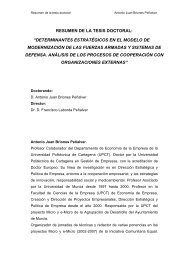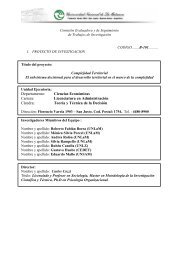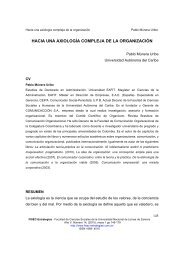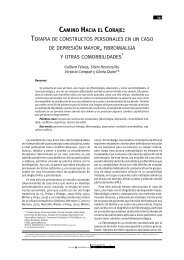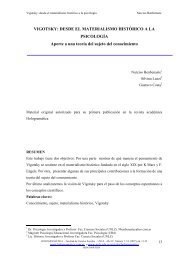Enfermedades del Aguacate* - cienciared
Enfermedades del Aguacate* - cienciared
Enfermedades del Aguacate* - cienciared
Create successful ePaper yourself
Turn your PDF publications into a flip-book with our unique Google optimized e-Paper software.
52 U POLITÉCNICA No. 4<br />
mayo - julio de 2007<br />
Autor<br />
PABLO JULIÁN TAMAYO MOLANO 1<br />
Ingeniero Agrónomo de la Universidad Nacional de<br />
Palmira. Magister Sciences de la Universidad Federal de<br />
Vicosa - Brasil. Investigador Agrícola <strong>del</strong> Centro de Investigación<br />
-La Selva- de CORPOICA. Correo Electrónico:<br />
laselva@corpoica.org.co<br />
Resumen<br />
Las actividades de diagnóstico e inspección a cultivos<br />
comerciales de aguacate (Persea americana Mill.), realizados<br />
por la Corporación Colombiana de Investigación Agropecuaria,<br />
CORPOICA, permitieron obtener un inventario de<br />
los principales limitantes fitopatológicos de este frutal en<br />
Colombia. Las enfermedades de mayor importancia, por<br />
su frecuencia y severidad en cultivos de aguacate, se destacan:<br />
La pudrición de raíces, causada por el hongo Phytophthora<br />
cinnamomi var. cinnamomi y la marchitez por Verticillium<br />
sp., las cuales normalmente ameritan decisiones<br />
de manejo. Son muy frecuentes e importantes, por su difícil<br />
manejo, las afecciones por Armillaria mellea y Rosellinia<br />
sp. en cultivos de aguacate en zonas de clima medio y frío<br />
moderado. Los hongos causantes de la roña (Sphaceloma<br />
perseae), la antracnosis <strong>del</strong> fruto (Glomerella cingulata), la<br />
mancha angular de la hoja y la mancha negra <strong>del</strong> fruto por<br />
Pseudocercospora purpurea, causan pérdidas importantes<br />
en el campo y en la poscosecha, al deteriorar la calidad de<br />
la fruta. Otros patógenos que afectan frutos en poscosecha,<br />
como Rhizopus stolonifer, Lasiodiplodia theobromae y<br />
Dothiorella sp., son de reciente aparición e importancia en<br />
cultivos de aguacate en Colombia. Otras enfermedades,<br />
como la muerte descendente de ramas, brotes y pudrición<br />
de injertos por C. gloeosporioides y L. theobromae, adquieren<br />
cada vez mayor importancia en viveros y almácigos.<br />
El secamiento de ramas y mancha foliar por Pestalotia sp.<br />
y la mancha algácea por Cephaleuros virescens, no son<br />
importantes en condiciones de campo. Por otra parte, la<br />
fumagina (Capnodium sp.) generalmente está asociada a<br />
insectos chupadores y es de fácil manejo.<br />
Palabras Clave<br />
Aguacate, <strong>Enfermedades</strong>, Reconocimiento, Colombia.<br />
Abstract<br />
The activities of diagnosis and inspection to commercial<br />
avocado (Persea americana Mill.) groves, realized by<br />
the Corporación Colombiana de Investigación Agropecuaria,<br />
CORPOICA, allowed to obtain an inventary of the<br />
main diseases of this fruit tree in Colombia. The diseases<br />
of major importance, for the frequency and severity<br />
in avocado groves, they are outlined: The rotting root<br />
caused by the fungi Phytophthora cinnamomi var. cinnamomi<br />
and the wilting for Verticillium sp., which normally<br />
deserve decisions of managing. Are very frequent and<br />
important, for the difficult managing, the affections for<br />
Armillaria mellea and Rosellinia sp. in avocado groves in<br />
zones of warm and moderate cold climate. The causal<br />
fungi of the scab (Sphaceloma perseae), the anthracnose<br />
of the fruit (Glomerella cingulata) and the angular leaf<br />
spot and black spot of the fruit for (Pseudocercospora<br />
purpurea), cause important losses in the field and in the<br />
postharvest, damaging the quality of the fruit. Others<br />
pathogens that affect fruits in postharvest, are Rhizopus<br />
stolonifer, Lasiodiplodia theobromae (= Botryodiplodia<br />
theobromae) and Dothiorella sp., wich are of recent appearance<br />
and importance in avocado groves in Colombia.<br />
Other diseases, as the descending death of branches,<br />
tips and rotting graft caused for C. gloeosporioides<br />
and L. theobromae, acquire every time major importance<br />
in nurseries. The dying of branches and leaf spot for Pestalotia<br />
sp. and the algal spot for Cephaleuros virescens,<br />
are not important in field conditions. On the other hand,<br />
the sooty mold (Capnodium sp.) generally it is associated<br />
with insects sucking and is of easy managing.<br />
Key Words<br />
Avocado, Diseases, Survey, Colombia<br />
1<br />
Corporación Colombiana de Investigación Agropecuaria, Corpoica. Centro de Investigación “La Selva”, Apartado Aéreo 100, Ríonegro - Antioquia, Colombia.



